Dell XPS 12 Review: A Jack of All Trades Flipscreen Ultrabook
by Jarred Walton on February 22, 2013 2:13 AM EST- Posted in
- Laptops
- Dell
- XPS
- Intel Insider
- Ultraportable
- hybrids
- Ultrabook
Battery Life Testing
As discussed in the Acer S7 review, we’re doing away with our former battery life suite and going with a bit more up-to-date tests. This is only the second laptop we’ve run through the new suite, so our database is a bit bare, so I’m just going to throw the results into a table. The Light test is our former Internet test, only with the LCD at 200 nits (50% for the XPS 12, or five steps down from maximum). Our Medium test uses the same Internet testing procedure but loads the pages every 12 seconds instead of every 60 seconds, and we add in playback of a bunch of 128Kbps MP3 files in Windows Media Player (with headphones connected and volume set to a “reasonable” level—around 40% in this case). Finally, for our heavy workload we keep the Internet portion of the Medium test but add in looped playback of a 1080p H.264 encoded video and have a constant 1Mbps download running from a local FTP server.
| 2013 Battery Tests | ||
| Battery Test | Acer Aspire S7 | Dell XPS 12 |
| 2013 Light (Minutes) | 240 | 321 |
| 2013 Medium (Minutes) | 173 | 257 |
| 2013 Heavy (Minutes) | 137 | 183 |
| Light Normalized (Min/Wh) | 6.86 | 6.83 |
| Medium Normalized (Min/Wh) | 4.94 | 5.47 |
| Heavy Normalized (Min/Wh) | 3.91 | 3.89 |
Dell’s XPS 12 wins on pure battery life compared to the Acer S7, but it’s largely thanks to the increased battery capacity. That adds weight as well as thickness, so it’s not necessarily a trade everyone will be willing to make. Interestingly, the Medium test is the exception, where even after normalizing for battery capacity the XPS 12 holds an 11% advantage over the S7. It’s not clear if this is thanks to some power optimizations or something else. Best case, however, we’re still looking at just over five hours of useful battery life between charges, with heavier usage bringing the system to the 3-4 hour range.
When we look at battery life with tablets is where these results are really put into perspective. The Surface Pro manages over five hours of H.264 decoding, but even that pales in comparison to the 10+ hours you can get out of most ARM-based tablets, and the iPad 2,4 makes it to the 15+ hour mark. Screen size and other components clearly play a role (an SSD drawing 0.5W would be a huge penalty compared to drawing 0.1W eMMC), but the entire Microsoft Surface RT device draws around 3W during movie playback at 200 nits compared to nearly 9W for the XPS 12 in our Light scenario and Surface Pro uses around 8W. Intel and their partners need to cut typical power draw in half if they want Haswell devices to be competitive with other SoCs.
Incidentally, at 100 nits and running our older 720p H.264 battery life test, the XPS 12 lasts right about four hours. Turn up the LCD to 200 nits and you can probably knock off another 20 minutes, so just over 3.5 hours of movie playback should be doable.
WiFi Performance
Considering there’s no Ethernet port on the XPS 12, WiFi performance becomes even more important for those that are doing any larger file transfers to/from the device. As someone who uses Gigabit Ethernet (and has been using it for roughly a decade), WiFi performance can be painfully slow. Copying the full suite of tests to a laptop over WiFi (around 18GB of data) can take the better part of an hour, and that’s when you have a good signal and no other interference. Switch to a 2.4GHz connection and things get even worse. Obviously USB 3.0 transfer rates are substantially faster, and for convenience sake I’d like to see some USB 3.0 to GbE adapters (Dell does sell a USB 2.0 to GbE adapter for $30, though I’m not sure what sort of real-world throughput it provides). I’d also like to see Dell and others move to 3x3:3 antenna configurations, something MacBook Pro has had for several years now.

Above is a quick check of WiFi performance compared with some tablets and other laptops. The XPS 12 is about average for a 2x2:2 solution, with slightly better throughput on 5GHz than on 2.4GHz. I’ve seen some WiFi adapters push closer to 150-200Mbps on a 5GHz 2x2:2 solution (e.g. the Amped Wireless adapter), so I’m not sure why most other WiFi adapters are so slow by comparison. Partly it’s probably Intel’s drivers, which may favor reliability or neighbor-friendliness over pure speed, but then on the XPS 12 the reliability aspect wasn’t all that great either.
Display Testing
I have to throw this out before I get into the display calibration results: I’m no longer confident that our testing procedure works properly for Windows 8 laptops. Everything looks okay, but either these new 1080p IPS displays are trading color quality for viewing angles or else the calibration routines aren’t working quite right. I mention this because the XPS 12 has great viewing angles and decent contrast but color accuracy and quality are decidedly average. And that’s after calibration—out of the box, Delta E is probably in the double digits. Here are the charts.
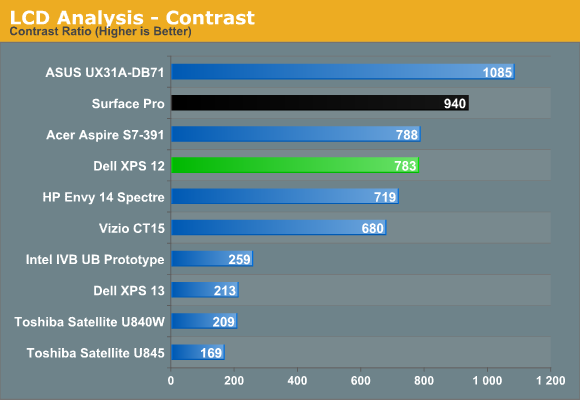
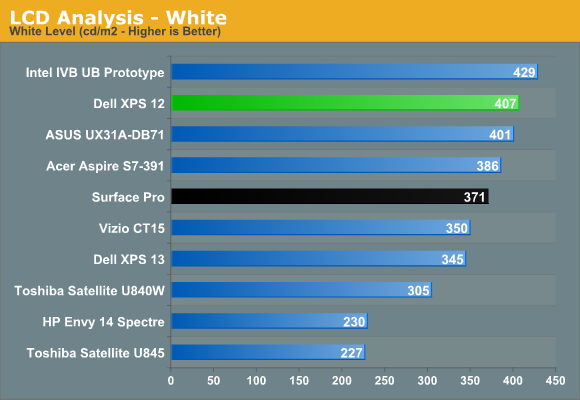
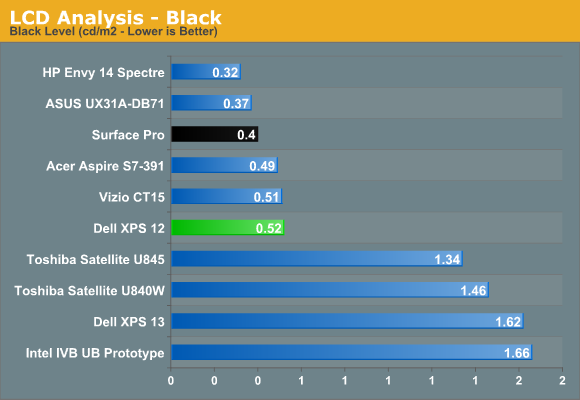
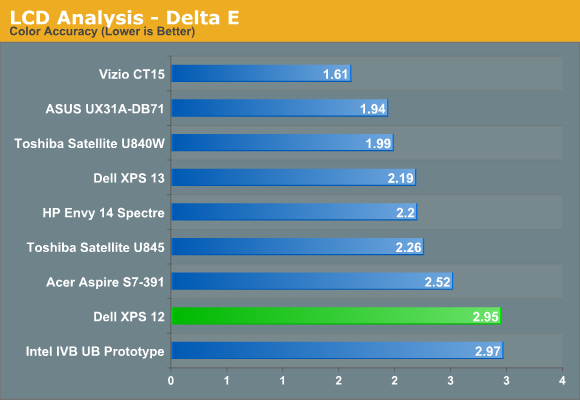
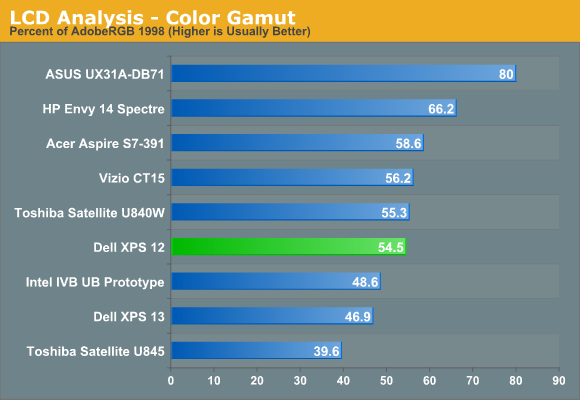
This once again highlights the need for OEMs to take displays seriously; Apple is spending the extra dollar or two (or maybe even five according to some rumors) to calibrate their laptop, tablet, and smartphone displays so that colors are reasonably accurate and color gamut matches the sRGB color space. Virtually everyone else is way off in terms of what colors are supposed to look like. While I can see not spending the extra money on a crappy TN panel in a $400 budget laptop, when we’re looking at $1200+ Ultrabooks the costs argument just doesn’t hold water. Ideally, every Ultrabook should be factory calibrated to deliver an average Delta E of less than three out of the box. Dell gets there post-calibration but only barely, and maximum brightness with the color profile loaded drops to around 300 nits.


_thumb.jpg)
_thumb.jpg)
_thumb.jpg)
_thumb.jpg)
_thumb.jpg)
_thumb.jpg)








59 Comments
View All Comments
Visual - Friday, February 22, 2013 - link
"(Note that the Surface Pro also comes with a pen, so that's probably a $50 add-on.)"Are you joking, or are you really that clueless?
It is not just the pen that is added there, it is an active digitizer layer added to the screen that costs at least $150. And it is worth every penny. No sane person would want a tablet without an active digitizer after having experienced using one for a time.
althaz - Friday, February 22, 2013 - link
Whilst I would not buy a tablet without a digitizer and pen, it's a bit of a stretch to say that no sane person would want one without it.JarredWalton - Friday, February 22, 2013 - link
$150 isn't what it would cost to add, but they might add that much to the price. Just like upgrading from a $90 quality TN panel to a $150 IPS panel often adds $300 to the price.redmist77 - Friday, February 22, 2013 - link
The flip screen is very sturdy (over-engineered if anything), works flawlessly and gives the best of both worlds. It's a bit strange to see the armchair experts in these comments passing extreme judgements despite clearly having zero experience with the product.This a fantastic Ultrabook with one of the best capacitive 1080 touch screens on the market that happens to fold into a tablet. Exactly what I wanted. I also *much* prefer glossy screens that add real depth and polish to on-screen images.
I'm sure pen support would be nice but the pen screens I've used aren't anywhere near as responsive, sensitive or accurate as this one.
My only minor gripe with the XPS12 is the poor color gamut.
Sazar - Friday, February 22, 2013 - link
I agree with most of your sentiments. I think I also lucked out on the color gamut because with very little tweaking, color's look great on my screen. In the interest of full disclosure however, I am partially color-blind :)My only concern has been a bug that is either tied to the panel, or Windows 8, where the touch-screen simply stops working. The only fix is to wake it after putting the system to sleep, or a reboot. Given how quickly it resumes or reboots, it doesn't take long to resolve, but it's annoying when it happens (about once or twice a month thus far).
There are new drivers for the touch pad as well that make it a lot better.
As an aside, for those interested, the frame is sturdy enough that you can flip the screen and then use the device in "tent" mode, like the Yoga. Works brilliantly.
alexvoda - Friday, February 22, 2013 - link
Please get Lenovo to send you a Thinkpad Helix review unit.I believe the Helix has the best combination of features and form factor with the only downside being the price.
It can be used in more ways than any other simmilar device.
IIRC the Helix is the only dockable tablet that an be docked in two ways giving it the use cases of both "flexible" laptops (Dell XPS12, Lenovo Yoga) and detachable tablets (Asus, Acer, Samsung).
rwei - Friday, February 22, 2013 - link
^ this.After using an x120e more and more while traveling, I'm a solid convert to the TrackPoint. It seems like the obvious solution for putting a pointing interface into a space-constrained device, particularly when complemented with a touchscreen (which obviates the need for many gestures).
Also love the option of just having the tablet on its own, which I'd probably do for my day-to-day use commuting in a subway.
Then, on a plane, I can put it in stand/combined tablet mode for battery life.
Then, when work inevitably gives me a task to work on during a trip, I can pop on the dock as a keyboard and deal with that.
All within 3.3lbs total + charger, barely more than the x120e.
Optionality is valuable $$$
damianrobertjones - Friday, February 22, 2013 - link
"RAM is soldered onto motherboard"- Slapping in Vengeance performance ram REALLY does help improve the HD4000 so it's a DAMN shame.
ssj3gohan - Friday, February 22, 2013 - link
Really? I was under the impression that intel IGPs didn't care much for RAM bandwidth, it's the AMD chips that really suffer when using slower (higher latency) RAM.But I'm not really into this stuff, could be wrong here.
Alexvrb - Saturday, February 23, 2013 - link
You're not entirely wrong. Intel's IGP doesn't scale as well or as far as AMD's integrated graphics (especially A8 and A10 APUs). This is especially evident in Intel's low-voltage variants (such as the one in this model), which employ lower base and sustained turbo clocks than their higher-power brethren (despite using the same name). With that being said, they could have benefited somewhat from using DDR3 1600 even without a full-factory-power HD4000.However, I'd bet that using slower memory is actually quite intentional. I suspect that they're using 1.25V DDR3U 1333 instead of 1.35V DDR3L. During development, they must have determined the hit to performance was not enough to outweigh using less power hungry memory - at least for this particular combination.